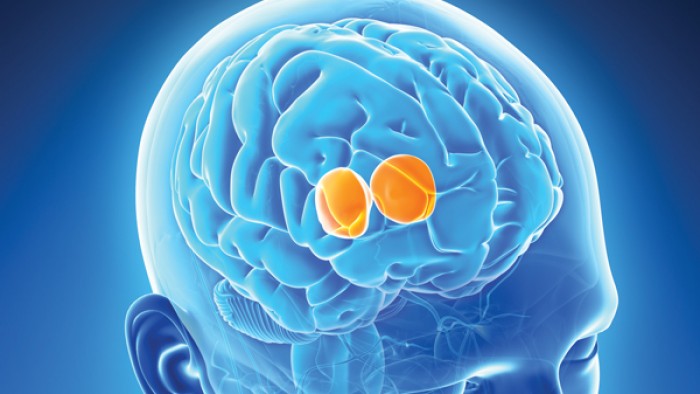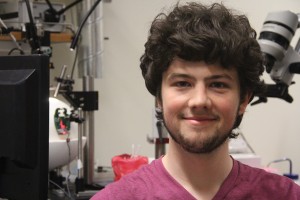 Natural Sciences
Natural Sciences
In the Mind’s Eye

There’s a lot we still don’t know about how vision works. For example, if we’re running or at rest, how does the brain adjust to help us see?
Neuroscientists are exploring this question. They’re looking at the thalamus, a structure in the middle of our brains composed of two bulb-shaped masses, each about the size and shape of a walnut (top). The thalamus is a relay stop for sensory information on its way to the part of the brain that controls vision.
Researchers at the UO are making exciting advances in this area, and they’re recruiting undergraduates such as Ian Etherington to play critical roles in labs where experiments are conducted.
Laboratory research has proven to be a defining experience in Etherington’s life. In the lab, working with faculty mentors and a team of scientists, he’s been able to build not only skills and confidence but also clarity about what comes next: a path toward helping others who suffer from neurological conditions like the one he has experienced himself.
Running or Resting
It’s only recently been discovered that a person’s active or passive behavior—running or resting—influences how the thalamus processes visual information.
Thanks to work by a team that includes UO neuroscientists Cris Niell and Denise Piscopo, we know that within the thalamus there are specific cellular routes for specific visual information. One set of these cells—called neurons—might handle an object moving left-to-right across our vision, for example, while another covers objects moving right-to-left. But these cells respond differently depending on whether or not the body is in motion.
Etherington, a biology major working in the Niell lab under former UO researcher Wayne Tschetter (now at Concordia University), conducted tests to determine whether running or resting affected the performance of neural channels. The team found that during running, cells that deal with the direction or orientation of a passing object respond more strongly; likewise, there is a stronger response by a special group of cells that help us see bland or low-contrast stimuli—a gray sky, for example.
For months, Etherington tested individual cells within the thalamus, observing the results on a monitor similar to an EEG. When a particular cell “fired” more strongly, for example, it showed up as more spikes in the wave moving across the screen.
Etherington’s running of experiments was integral to the project, according to Niell. “These are the things that make the lab go,” he said. “I’m in my office writing papers and grants. It’s people like Ian who are the ones in there doing the experiments. Ian kept the project moving forward—it’s like having an extra engine on board.”
The payoffs of research are significant for undergraduates such as Etherington.
For one, it enables students to take what they learn in class to the next level.
Although courses such as organic chemistry include time in the lab, experiments are often carefully designed to reinforce what is being taught. In a research lab, by comparison, the only goal of the experiment is to test a hypothesis. It’s up to the researcher to call on ideas and theories from the classroom in service to the project.

Ian Etherington
Projects in a research lab offer opportunities “to reach for classroom concepts that you need,” Etherington said. “It’s a very effective way to learn.”
There are the résumé-building benefits of research, as well. Etherington’s hands-on work with fundamental neuroscience—recording and listening to the activity of cells—would be a rare strength even among graduate students interviewing for lab positions, Niell said.
Perhaps most important, though, is a skill Etherington is developing that will serve him regardless of his career path—learning to think like a scientist.
“How do you think about analyzing data? How do you troubleshoot things? How do you research a question?” Niell said. “Ian has developed a lot of ingenuity, a lot of creativity.”
He recalled, for example, Etherington’s solution for a tedious lab task. The needle-like probes used for recording cell activity must be repeatedly dipped in solution for cleaning. Etherington, who had been scouring old literature on similar projects, found that sewing machines had been retooled to function as automatic dunkers.
“He’s a problem solver,” Niell said. “He’s learning those general research skills that you just can’t get in a course. These are highly sought-after skills, regardless of the kind of work you do.”
Don’t Break Anything
When Etherington first joined the project, one of his first thoughts was don’t break anything.
As an undergraduate making a first foray into research, Etherington found it easy to feel overwhelmed. There is a steep learning curve in grasping both the scientific questions in play and the complicated techniques that will be used to try to answer them.
“It’s like starting any new job—there is so much to read and understand and so many questions to ask people in the lab,” Etherington said. “One of my first days in the lab, I was given a stack of papers to read—it was like drinking from a fire hose, just trying to absorb the background.”
As he found his footing, though, Etherington became increasingly invested in the project and its importance. He was thrilled by the team’s breakthroughs and amazed by the insight into the inner workings of the brain.
“It’s like spying on something that you’re never supposed to know is happening,” Etherington said. “Pulling back the curtain on how the brain works—it’s mind-boggling to me, and extremely compelling.”
The project has given Etherington the confidence that he can be “more than just a bystander to science”—he can get involved, he can be a part of creating knowledge.
“For a long time, I was pretty squeamish about neuroscience,” Etherington said. “But at some point, I started to wonder if it might actually be freeing and empowering to understand what is going on in the brain as we experience life.”
Etherington’s interest in the workings of the brain is, on one level, personal: He has struggled with obsessive-compulsive disorder, a deeply frustrating experience, he said, and in many ways, a hindrance to academic life.
But the disorder has also served Etherington to some extent. It makes him “pathologically tenacious,” he said—an excellent attribute in a scientist—and it has helped him define a career trajectory.
Etherington is on a track to wear three hats in neuroscience, as a physician-scientist-professor. He wants not only to find solutions in the lab, but also to present them to patients and pass along this knowledge to the next generation of doctors and researchers. He plans to focus on neurological disorders such as OCD, autism and schizophrenia.
Driving Curiosity
To that end, Etherington has shaped his education and research at the UO to give him solid foundational knowledge of neuroscience and its underpinnings, biology and chemistry.
“I want to be on the frontlines and working with patients, but I also want to be able to say to them, ‘I’m working on something to make our treatment options better,’” he said. “Straddling that rift between medicine and science has long been something that has compelled me. The only question is whether I can handle the workload to get there.”
Niell has seen indications that Etherington has the makeup to do it.
He still remembers his first encounter with the student. Then just a freshman, Etherington buttonholed Niell on an obscure paper from the scientist’s distant past, but one that Etherington had found fascinating and had studied closely: Was Niell aware of any additional developments? Had anyone else looked into the intriguing questions that had been left unanswered?
It showed to Niell the kind of driving curiosity that successful scientists must bring to this demanding work. Then, in the researcher’s lab, Etherington put that passion for knowledge to work, establishing himself as an independent thinker who can also make contributions to the team.
“Ian set the example for undergraduates working in the lab—he has the creativity, the ideas, and he can self-motivate,” Niell said. “He showed me what undergraduates can do.”
—Matt Cooper


 Twitter
Twitter Facebook
Facebook Forward
Forward